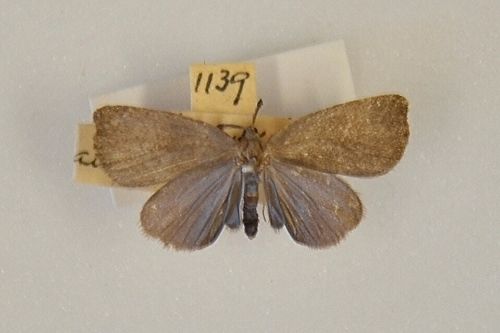|
|
Post by nomad on Feb 8, 2015 2:13:31 GMT -8
The extinction of two species of Fijian Zygaenidae by Biocontrol. Two small species of Zygaenidae endemics, the serious pest Levuana iridescens and the harmless Heteropan dolens were eradicated by professional entomologists using biocontrol. Coconut Plantations were the main economy of the native peoples of the Fijian Islands in the late 1800s to early 1900s. From around 1877, coconut plantations on Viti Levu were severely affected by Levuana iridescens (Bethune Baker), a small purple moth,whose larvae trenched the underside of the leaves and the Palms died. Chemical spraying failed. In 1925 entomologists imported and released a parasitic fly- Bessa remota ( Aldrich) on the island Viti Levu. This provided immediate control of the moth, eventually leading to its extinction on that Island. L. iridescens has not be seen since the 1950s. The parasitic flies also preyed upon the larvae of the pretty and harmless Fiji Viti Levu endemic, Heteropan dolens and is now thought to be extinct. Repeated searches over many years have failed to find any extant population. Howarth wrote that H. dolens was extinct by 1929.  The only specimen of Heteropan dolens in the collections of the O.U.M.N.H.  Heteropan dolens. Painting from Herbert Druce, ' List of Lepidoptera - Herocera collected by Mr. C.M. Woodford at Suva, Viti Levu, Fiji Islands, with the ' Descriptions of some new species. 'Proceedings of the Zoological Society of London 219-231. 1888.  Levuana iridescens. |
|
Deleted
Deleted Member
Posts: 0
|
Post by Deleted on Feb 8, 2015 16:17:36 GMT -8
It is a shame to drive any species to extinction no matter how troublesome it is.
|
|
|
|
Post by nomad on Feb 9, 2015 13:12:38 GMT -8
I agree. I guess the entomologist's who did this, perhaps did not understand the significance of their actions. Although, it was done to save a important food resource for the islanders, we can add another two species to the extinction list through man's hand.
|
|
surroundx
Junior Member
  REPAD logo, hinting at our incomplete picture of recent extinctions
REPAD logo, hinting at our incomplete picture of recent extinctions
Posts: 26
|
Post by surroundx on Apr 12, 2015 3:36:13 GMT -8
|
|
|
|
Post by exoticimports on Apr 14, 2015 5:06:31 GMT -8
As a side note, I wonder how many Fijian species went extinct with the massive sugarcane industry and logging. The indigenous parrots and iguanas are quite rare, one can draw the corollary that the same happened to insects.
|
|
|
|
Post by nomad on Apr 14, 2015 10:01:03 GMT -8
As a side note, I wonder how many Fijian species went extinct with the massive sugarcane industry and logging. The indigenous parrots and iguanas are quite rare, one can draw the corollary that the same happened to insects. Quite a few, I expect, seeing as Fiji has lost nearly all of its rainforest. |
|
|
|
Post by exoticimports on Apr 16, 2015 6:19:52 GMT -8
As a side note, I wonder how many Fijian species went extinct with the massive sugarcane industry and logging. The indigenous parrots and iguanas are quite rare, one can draw the corollary that the same happened to insects. Quite a few, I expect, seeing as Fiji has lost nearly all of its rainforest. Well, that's not actually true. The inside half of Viti Levu is still covered with thick old growth jungle. Thus, highlands jungle species should still be OK. However, the plain along the coast, which extends roughly 10km inland all the way around, has been totally logged, which means that any lowlands jungle species are in danger. The other mountain islands have seen far less logging. Oddly enough, many of the smaller islands have been completely logged of ironwood (Vesi, they call it) for the carving trade for tourists. Tongatapu, the main island of Tonga, has been completely logged and AFAIK has zero original forest remaining. Vanuatu and Solomon Islands still have huge tracts of original forest, though that is changing fast- but the good thing is that some of the internal terrain is so mountainous that it cannot be logged. The sad thing is that with so many Pacific species disappearing, it would be of benefit to discover and/or document them; BUT the governments are typically anti-collecting of anything, so unless one gets a grant and associated with a major museum, nothing happens. PNG is the worst, good luck studying anything there unless associated with BMNH or Smithsonian. |
|